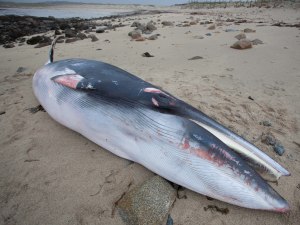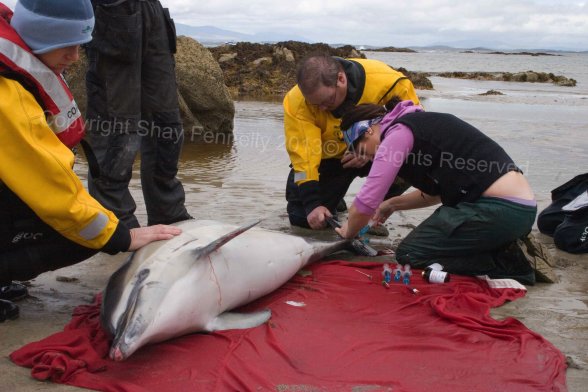Learn how to fish, catch a mackerel, fresh from the sea
Source: Mackerel
Learn how to fish, catch a mackerel, fresh from the sea
Source: Mackerel
EU Member States are required to design annual monitoring schemes for incidental catch of cetaceans on their vessels, in accordance with Council Regulation (EC) No 812/2004 of 26.4.2004*. BIM and the Marine Institute have funded pilot independent observer programs for 200 days undertaken by UCC and GMIT in 2011 and 2012.
Five GMIT observers carried out a total of 15 fishing trips in 2011-2012(90 days).No cetacean bycatch was observed during any of the fishing trips.The overall coverage achieved was 60% of that targeted. There were difficulties in finding vessels to place observers on which could be attributed to vessels operating from overseas ports and uncertainties as to which overseas port landings would be made in. Other difficulties encountered included shortage of berths and boat operators being unwilling to take observers. To ensure full coverage, it is recommended that specific undertakings to accommodate observers on a boat by boat basis should be agreed prior to the start of each observer study. This should be done in consultation with Fish Producers Organisations and other relevant management bodies.
UCC observers undertook thirty trips on 22 different vessels (111 days). There was no cetacean incidental take observed during the programme. 10 gannets (Morus bassanus) caught in pelagic gear, six of which were released alive, during pelagic fishing for mackerel, horse mackerel and herring.
It is not clear whether an increase in observation effort in pelagic trawls would result in cetacean by catch being detected.
It is up to the Flag State to put observers on Fishing trawlers to monitor by catch.

A young Minke whale 6.40 metres in length was stranded on Omey Island, County Galway 25/11/2015.Prior to its stranding a pelagic factory trawler, FV Margiris was fishing off the Galway west coast. In Ireland there is no post mortem scheme to determine the cause of death of whales and dolphins even though such strandings are at an all time high.
Photo copyright Shay Fennelly/Aquaphoto

Mayo Irish Coastguard members assist a vet to humanely end the suffering of a stranded Common dolphin that could not be refloated. Photo by Shay Fennelly/Aquaphoto
It would appear that no post mortems have been carried out on the Pilot whales recently stranded in Donegal. Whales and dolphins are threatened by pelagic fishing, noise pollution from low frequency sonar by naval exercises and by state licensed seismic surveys by oil and gas companies in Ireland’s, ‘whale and dolphin sanctuary’.
I am interested in acoustics and how man made underwater noise may impact on marine mammals. The link is a recent article I wrote about it.
http://issuu.com/inshoreirelandpublishing/docs/10.2_issuu/20
For marine mammals that depend on sound to communicate, reproduce and find their way in the ocean, is it cruel to bombard them with high intensity noise?
http://www.ispca.ie/legal_handbook/
What animals are protected by the Protection of Animals legislation?
The Protection of Animals Acts, 1911 and 1965 are the principal statutes which prohibit the maltreatment of animals.
Initially, the scope of this Act extended only to domestic or captive animals (Section 15 of the 1911 Act), a domestic animal being any tame animal, or any animal which had been sufficiently tamed to be put to use by humans. Captive animals are those whose freedom is curtailed by use of cages, pens, ropes, pinions, or other device. Animals in the wild remained vulnerable to wanton acts of cruelty under the 1911 Act.
The 1965 Act, however, extended the definition to include all wild animals, Section 13(a). By virtue of these provisions, it is now unlawful to commit acts of cruelty on any animal.
It appears that all wild animals are protected from cruelty including whales and dolphins in Ireland. Some of the acts of omission would appear to me to constitute maltreatment of wild animals.
Who Killed the Dolphins? – Report-shows-13-dolphins-died-entangled-in-fishing-gear-off-County-Mayo
Minister Simon Coveney is mistaken, “On the basis of these examinations, it is not possible to determine which of these fleets might have been involved in this incident.”
If he wishes it can be investigated further, all vessel names and movements are monitored by the Vessel Monitoring System of the Irish Navy.
http://www.military.ie/naval-service/organisation/specialist-units/fisheries-monitoring-centreAlso the Irish Coastguard can track oil spills and could also backtrack the direction of where the stranded dolphins came from. Match the two and you can fairly identify where the dolphins were likely caught. Interview the vessel skippers and identify those responsible and prosecute. The Minister can ensure the law is enforced for all strictly protected species in Ireland’s whale and dolphin ‘sanctuary’
Post mortem on stranded dolphins suggests fishery by catch is the cause of death
http://www.npws.ie/publications/archive/Dolphin%20postmortem%202013.pdf